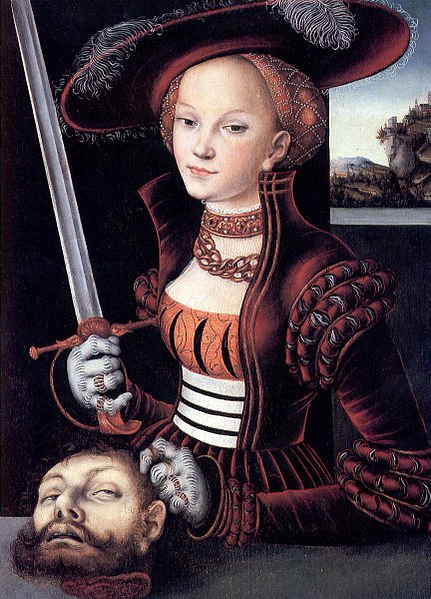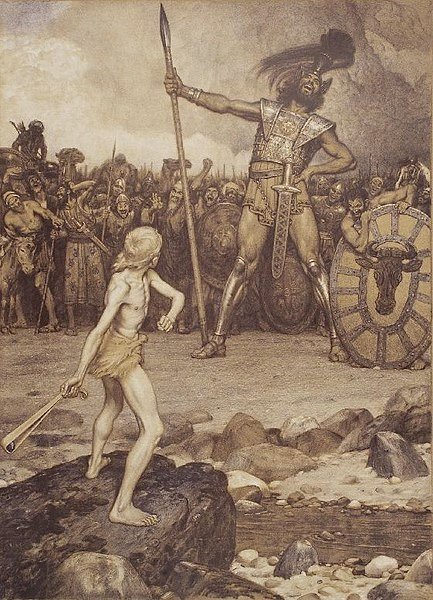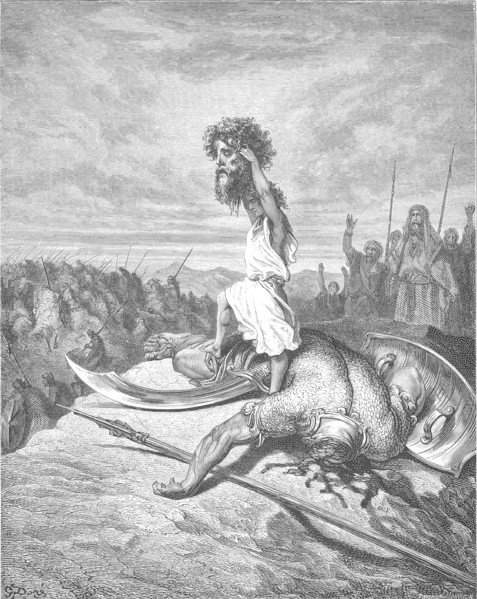Saint Judy and Saint David, braining bullies since before the prince of peace
Our Sun as an esoteric symbol is associated with the virtue of humility and the vice of pride. Our moon as an esoteric symbol is associated with the virtue of gracefulness and vice of sloth. Sloth has also been defined as a failure to do things that one should do, though the understanding of the sin in antiquity was that this laziness or lack of work was simply a symptom of the vice of apathy or indifference, particularly an apathy or boredom with God.
Most of the capital sins, with the sole exception of sloth, are defined by Dante Alighieri as perverse or corrupt versions of love for something or another: lust, gluttony, and greed are all excessive or disordered love of good things; sloth is a deficiency of love; wrath, envy, and pride are perverted love for Sunday and Monday sake.
What is St Judith the patron saint of?
In the Roman Catholic Church, she is honored as the patron saint of Prussia, and her feast day is observed on 5 May.

Who does Judith kill?
In Artemisia Gentileschi's painting Judith Slaying Holofernes (Naples), she demonstrates her knowledge of the Caravaggio Judith Slaying Holofernes of 1612; like Caravaggio, she chooses to show the actual moment of the killing.
The account of the beheading of Holofernes by Judith is given in the deuterocanonical Book of Judith, and is the subject of many paintings and sculptures from the Renaissance and Baroque periods. In the story, Judith, a beautiful widow, is able to enter the tent of Holofernes because of his desire for her. Holofernes was an Assyrian general who was about to destroy Judith's home, the city of Bethulia. Overcome with drink, he passes out and is decapitated by Judith; his head is taken away in a basket (often depicted as being carried by an elderly female servant).
Artists have mainly chosen one of two possible scenes (with or without the servant): the decapitation, with Holofernes supine on the bed, or the heroine holding or carrying the head, often assisted by her maid. An exception is an early sixteenth-century stained glass window with two scenes. The central scene, by far the larger of the two, features Judith and Holofernes seated at a banquet. The smaller background scene has Judith and her servant putting Holofernes' head in a sack, the headless body standing behind with his arm waving helplessly. The subject is one of the most commonly shown in the Power of Women topos.

In European art, Judith is very often accompanied by her maid at her shoulder, which helps to distinguish her from Salome, who also carries her victim's head on a silver charger (plate). However, a Northern tradition developed whereby Judith had both a maid and a charger, famously taken by Erwin Panofsky as an example of the knowledge needed in the study of iconography. For many artists and scholars, Judith's sexualized femininity interestingly and sometimes contradictorily combined with her masculine aggression. Judith was one of the virtuous women whom Van Beverwijck mentioned in his published apology (1639) for the superiority of women to men, and a common example of the Power of Women iconographic theme in the Northern Renaissance.
Goliath is described in the biblical Book of Samuel as a Philistine giant defeated by the young David in single combat, serving as the representative of paganism, in contrast to David, the champion of the God of Israel. Christian tradition sees the story as prefiguring Jesus' victory over sin and the Church's victory over Satan.

The phrase "David and Goliath" (or "David versus Goliath") has taken on a more popular meaning, denoting an underdog situation, a contest where a smaller, weaker opponent faces a much bigger, stronger adversary.

The Goliath narrative in 1 Samuel 17
Saul and the Israelites are facing the Philistines in the Valley of Elah. Twice a day for 40 days, morning and evening, Goliath, the champion of the Philistines, comes out between the lines and challenges the Israelites to send out a champion of their own to decide the outcome in single combat, but Saul is afraid. David, bringing food for his elder brothers, hears that Goliath has defied the armies of God and of the reward from Saul to the one that defeats him, and accepts the challenge. Saul reluctantly agrees and offers his armor, which David declines, taking only his staff, sling and five stones from a brook.
David and Goliath confront each other, Goliath with his armor and javelin, David with his staff and sling. "The Philistine cursed David by his gods", but David replies: "This day the Lord will deliver you into my hand, and I will strike you down; and I will give the dead bodies of the host of the Philistines this day to the birds of the air and to the wild beasts of the earth; that all the earth may know that there is a God in Israel, and that all this assembly may know that God saves not with sword and spear; for the battle is God's, and he will give you into our hand."
David hurls a stone from his sling and hits Goliath in the center of his forehead, Goliath falls on his face to the ground, and David cuts off his head. The Philistines flee and are pursued by the Israelites "as far as Gath and the gates of Ekron". David puts the armor of Goliath in his own tent and takes the head to Jerusalem, and Saul sends Abner to bring the boy to him. The king asks whose son he is, and David answers, "I am the son of your servant Jesse the Bethlehemite."
What are the 6 pieces of the armor of God?
The 6 Pieces Of Armor For Christians
1 The Belt of Truth. "So stand strong with the belt of truth tied around your waist," (Ephesians 6:14). ...
2 A Breastplate of Righteousness. "-and on your chest wear the protection of right living." ...
3 On your feet, the Gospel. ...
4 The Shield of Faith. ...
5 God's Salvation as your Helmet. ...
6 The Spirit as your Sword.
Concrete thinking refers to the thinking on the surface whereas abstract thinking is related to thinking in depth. Concrete thinking does not have any depth. It just refers to thinking in the periphery. While some mental process is involved in abstract thinking, no such effort is evolved in concrete thinking.
A subtle body is one of a series of psycho-spiritual constituents of living beings, according to various esoteric, occult, and mystical teachings. According to such beliefs each subtle body corresponds to a subtle plane of existence, in a hierarchy or great chain of being that culminates in the physical form.
According to Bhagavad Gita, one of the most sacred texts of Hinduism, the subtle body is composed of mind, intelligence and ego, which controls the gross physical body. It is also known in other different spiritual traditions: "the most sacred body" (wujud al-aqdas) and "true and genuine body" (jism asli haqiqi) in Sufism, "the diamond body" in Taoism and Vajrayana, "the light body" or "rainbow body" in Tibetan Buddhism, "the body of bliss" in Kriya Yoga, and "the immortal body" (soma athanaton) in Hermeticism. The various attributes of the subtle body are frequently described in terms of often obscure symbolism: Tantra features references to the sun and moon as well as various Indian rivers and deities, while Taoist alchemy speaks of cauldrons and cinnabar fields.
Military Mothers of this earth in 2018, EZRI and the prince of peace playing with the Kumari
noun: emotional intelligence
the capacity to be aware of, control, and express one's emotions, and to handle interpersonal relationships judiciously and empathetically.
The Yogic, Tantric and other systems of Hinduism, Vajrayana Buddhism, as well as Chinese Taoist alchemy contain theories of subtle physiology having a number of focal points (chakras, acupuncture points) connected by a series of channels (nadis, meridians) that convey subtle breath (prana, vayu, ch'i, ki, lung).
These invisible channels and points are understood to determine the characteristics of the visible physical form. By understanding and mastering the subtlest levels of reality one gains mastery over the physical realm. Through practice of various breathing and visualization exercises one is able to manipulate and direct the flow of vital force, to achieve supernormal powers (Sanskrit: siddhis) and attain higher states of consciousness, immortality, or liberation.
John 14:2 My Father's house has many rooms; if that were not so, would I have told you that I am going there to prepare a place for you?
Abstract thinking is a level of thinking about things that is removed from the facts of the “here and now”, and from specific examples of the things or concepts being thought about. Thus, for example, a concrete thinker can think about this particular dog; a more abstract thinker can think about dogs in general.
Knowledge is power, power corrupts, braining the bullies, sloth's pride erupts!
Is pride a virtue or a vice?
When viewed as a virtue, pride in one's abilities is known as virtuous pride, greatness of soul or magnanimity, but when viewed as a vice it is often known to be self-idolatry, sadistic contempt, vanity or vainglory.
Dare say a megalomania xenophobe, narcissistic personality disorder?
Perhaps slackers from Austin Texas may reason philosophical pearls of wisdom conveyed in weird humanitarian as well spiritual arts to express justice from such notions.
Figuratively is also an adjective, but its meaning is quite different from literally. Figuratively is defined as based on or making use of figures of speech; metaphorical. So while literally means free from any metaphor or allegory, figurative deals specifically with these kinds of figures of speech.
Giving Credit to the Texas Able program: Pricing Revolution
I dedicate this article to my aunt Judy and my uncle David. Ya'll are way cool. Thanks for keeping the faith. That's so cool.